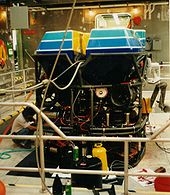- Monterey Bay Aquarium Research Institute
-
The Monterey Bay Aquarium Research Institute (MBARI) is a not-for-profit oceanographic research center in Moss Landing, California affiliated with the Monterey Bay Aquarium. It was founded in 1987 by David Packard of Hewlett-Packard fame. Scientists, engineers, and institute staff conduct a large variety of research projects ranging from studies on the molecular biology, bioluminescence, canyon processes, benthic biology, and global climate change. Moss Landing was chosen as the location for MBARI because it is located in the center of Monterey Bay, at the head of the Monterey Canyon, and is one of the most diverse marine-life areas on earth.
The institute is not open to the general public, but it has an open house once a year for same. Approximately 220 people work at MBARI—the operating budget is about $30,000,000 per year.
Contents
Research vessels
MBARI operates three research vessels on a routine basis for both resident and visiting scientists and engineers. The R/V Western Flyer is a twin hull ship deploying a remotely operated vehicle, the ROV Doc Ricketts, through a moon pool in the center of the ship and is generally used for multi-day expeditions. The Doc Ricketts is a 4 km depth rated vehicle, named after the pioneer marine ecologist Ed Ricketts. ROV Tiburon, which had been deployed from the R/V Western Flyer since 1997, was officially retired in 2009. Tiburon, meaning "shark" in Spanish, was named by engineer Daniel Davis after he noted the shark-like power and violent turbulence Tiburon expelled from her thrusters. The R/V Point Lobos operates daily with its ROV, Ventana. The ROV Ventana is a 1.8 km depth rated vehicle. The R/V Zephyr also operates frequently and is used to deploy MBARI's AUVs as well as a support vessel for mooring (buoy) operations.
Projects
One of the Institute's resident geneticists, Robert Vrijenhoek, led a team of researchers to the South Pacific in 2006 to study the lifeforms inhabiting the hydrothermal vents in the sea floor. Using the submersible Alvin, the team brought back a living Kiwa hirsuta - a furry crustacean from a biological family previously unknown to science.[1] MBARI is also a partner with the Monterey Bay Aquarium and Stanford University in supporting the Center for Ocean Solutions, a nonpartisan organization that brings together marine science and policy to develop solutions to the challenges facing the oceans.
References
- ^ Dean, Cornelia (14 March 2006). "In the Deep, Deep Sea, the 'Yeti Crab'". New York Times. http://www.nytimes.com/2006/03/14/science/14find.html?_r=1&scp=6. Retrieved 2010-12-06.
External links
Coordinates: 36°48′08″N 121°47′17″W / 36.80221°N 121.78803°W
Categories:- Oceanographic institutions
- Buildings and structures in Monterey County, California
- Monterey Bay Aquarium
- Oceanography stubs
Wikimedia Foundation. 2010.




